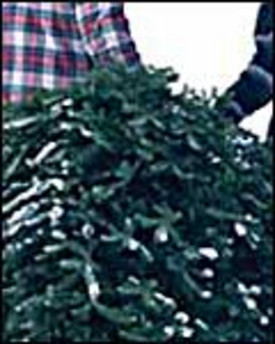 |
||
|
|
Almost all trees today are grown on farms where they’re specially bred and nurtured for 5 to 10 years for their moment of glory in someone’s living room. Many tree farms have wonderful cut-your-own-tree programs where one can bring the children for a nostaligic visit.
It’s fascinating how a tree has become such a universal symbol of Christmas. Ever wonder how it all got started?
Long before the birth of Jesus, prehistoric civilizations believed that evergreen trees meant long life and immortality.When deciduous plants lost their leaves and looked dead, early man worried that they would not return. He venerated the evergreen plants, which seemed to defy death, and stay alive during the cold dark winter.
The Teutonic tribes thought that spirits inhabited the branches of evergreen trees and most early civilizations believed that large old trees were mystical, awesome and suitable for worship.
Holly
This was the plant most prized by pagan German and British tribes to ward off evil spirits and bad weather. Later, maidens kept it to protect their virtue, and holly berries, which are poisonous, were used for medicinal tea.
Herbals
It is interesting that most herbals, even today, are actually poisons, and it is their bad side effects that are prescribed. Mistletoe, a poisonous parasite of oak trees, was a sacred Druid medicine.
In Biblical times people gathered evergreens on the winter solstice, the shortest day of the year, believing them to be symbols of life.
Ancient Romans decorated their homes with evergreen branches for the festival of Saturnalia in mid-December, which also involved a whole lot of wine and partying.
The poor persecuted early Christians, not wanting to offend, decorated their houses too. The church tried to stamp out the pagan customs, but with little success.
Decorating the Tree
Supposedly, the earliest decorated tree was in Riga, Latvia in l510, where merchants fancied up a tree with flowers. (Please bear in mind that all this information is grounded in historical hearsay, not archaeological fact.)
The idea of tree decorations spread and later trees decorated with candles and cookies became very popular, especially in Germany where they were called Christbaum. The Germans who settled in colonial Pennsylvania brought their Christbaum tradition and so it became part of our culture. However, it took a few more years and Queen Victoria to popularize it.
It seems that in 1848, The Illustrated London News printed a picture of the Queen, all her children and her beloved Prince Albert (who was German) in front of a decorated Christmas tree. Two years later, Godey’s Lady’s Book brought the idea here, and voila, it became the rage.
Ornaments
As the fad grew, so did the ornamentation. Tin ornaments were made to reflect candlelight. Very sophisticated ornaments of gold and silver covered cardboard were made in Dresden where there was a fondness for animal shapes.
Then, in the town of Lauscha, Germany, famous since the Middle Ages for glass blowing, a few folks blew some glass bubbles for fun one Christmas. Someone swirled silver inside and mirrored them. Soon the little town spent the whole year making glass baubles in all shapes and colors to satisfy the Christmas market.
Lights
In 1879, just 3 years after Edison’s invention, the first electric tree lights were made. The 80 bulb string cost the equivalent of about a thousand dollars today. In l903, GE produced a set costing only twelve dollars, which was still an average weekly wage. Today we can have twinkly lights and shiny decorations for much less on a tree lovingly grown on a farm. And as beautiful as ever it still is.
Credit: Mother’s Garden




























